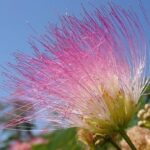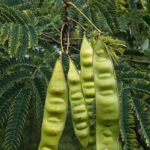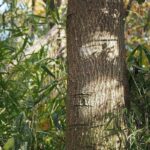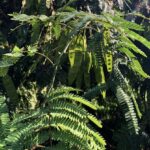On the Lookout for Non-Native Invasive Plants: Mimosa
go.ncsu.edu/readext?1083725
en Español / em Português
El inglés es el idioma de control de esta página. En la medida en que haya algún conflicto entre la traducción al inglés y la traducción, el inglés prevalece.
Al hacer clic en el enlace de traducción se activa un servicio de traducción gratuito para convertir la página al español. Al igual que con cualquier traducción por Internet, la conversión no es sensible al contexto y puede que no traduzca el texto en su significado original. NC State Extension no garantiza la exactitud del texto traducido. Por favor, tenga en cuenta que algunas aplicaciones y/o servicios pueden no funcionar como se espera cuando se traducen.
Português
Inglês é o idioma de controle desta página. Na medida que haja algum conflito entre o texto original em Inglês e a tradução, o Inglês prevalece.
Ao clicar no link de tradução, um serviço gratuito de tradução será ativado para converter a página para o Português. Como em qualquer tradução pela internet, a conversão não é sensivel ao contexto e pode não ocorrer a tradução para o significado orginal. O serviço de Extensão da Carolina do Norte (NC State Extension) não garante a exatidão do texto traduzido. Por favor, observe que algumas funções ou serviços podem não funcionar como esperado após a tradução.
English
English is the controlling language of this page. To the extent there is any conflict between the English text and the translation, English controls.
Clicking on the translation link activates a free translation service to convert the page to Spanish. As with any Internet translation, the conversion is not context-sensitive and may not translate the text to its original meaning. NC State Extension does not guarantee the accuracy of the translated text. Please note that some applications and/or services may not function as expected when translated.
Collapse ▲There are a wide variety of non-native invasive plant species that have taken hold in Madison County. These plants cause harm to the environment, as well as potential harm to human, animal, and plant health in the preexisting environment. Some of these damages can be caused by overtaking beneficial native plants in the ecosystem, act as vectors for diseases and other invasive species, such as invasive insects, and are unhealthy or potentially toxic to native animals. In this series, we will discuss identification and control of these prevalent invasive plants.
Identifying Mimosa
Mimosa trees (Albizia julibrissin), also known as silk trees, are an invasive species of plant that originated in southern and eastern Asia, from Iran all the way to China and Korea. It was introduced into the United States in 1745, and has since widely spread across the country, from New York to Florida, and out as far west as California. It is a short-lived, small to medium sized tree with a height that generally ranges from 10-50 feet tall with a canopy that spreads about 20-50 feet. The trunks of these trees can be either a single stem or multiple, and are covered in a thin, pale bark dotted with raised, pore-like spots known as lenticels. This invasive species is very tolerant of the summer heat, can live in both full sun and partial shade, and its pink, pompom-like flowers made of which bloom from May to July, prefer full sun. These pink flowers are 1 to 3 inches long, fragrant, and often attract pollinators such as bees, butterflies, and hummingbirds, but the trees have weak limbs that can be easily broken in snow, ice, and windstorms. On the ends of the branches rest leaves that look much like those on ferns, usually 5 to 8 inches long. Each flower produces anywhere from 5 to 16 seeds, which appear from August to September, this species produces pod-like fruits that resemble flattened pea pods in a straw-like color that are about 6 inches long and remain on the tree throughout the winter.
Mimosa trees are tolerant of many different soil types, light, and moisture conditions, making them more competitive in a variety of areas. They can grow in dense stands as well, allowing it to overrun a variety of areas. The pod-like fruits pose a danger to pets and livestock, as the seeds contain a neurotoxin that is dangerous to pets and livestock when ingested. These trees are most often spotted in some of the lower elevation areas throughout the county, as they do not prefer elevations over 3,000 feet.
- Full Growth Jim Robbins CC BY-NC-ND 4.0 Image retrieved from NC Extension Gardener Plant Toolbox
- Albizia julibrissin bloom detail Martin Labar CC BY-NC 2.0 Image retrieved from NC Extension Gardener Plant Toolbox
- Albizia julibrissin seed pods Katja Schulz CC BY 2.0 Image retrieved from NC Extension Gardener Plant Toolbox
- Albizia julibrissin bark Harum Koh CC-BY-SA 2.0 Image retrieved from NC Extension Gardener Plant Toolbox
- Seed Pods & Leaves- Aug. 9 – Wake Co., NC Cathy DeWitt CC BY-NC-ND 4.0 Image retrieved from NC Extension Gardener Plant Toolbox
How It Spreads
Mimosa trees are often found along roadsides, in grasslands, vacant lots, clearings, and in flood plain areas. This invasive species also poses a threat to natural areas like streambanks due to the flat pod-like fruits helping to disperse their seeds out along areas of moving water like streams, creeks, and rivers. The seeds can also be easily dispersed by animals, and are covered in an impermeable coating that allows them to continue to reproduce long after they are first distributed. The seed pods are lightweight, and can also be easily spread on moving winds, much like they are distributed through the movement of water. As mentioned before, Mimosa can take root in many different soil, light, and moisture conditions, aiding in its ability to spread through a wide array of ecosystems, but it prefers lower elevations (under 3,000 feet). If these invasive plants have been planted as ornamental plants near homes, they require intense clean up from heavily shedding leaves, blooms, and those abundant seed pods to help prevent it from growing into dense stands that choke out native plant life. If the mimosa is cut back, it will resprout from the existing root system.
Controlling Mimosa
When small patches of young Mimosa seedlings begin to appear, they can be controlled using hand pulling, but when the trees begin to mature, pulling no longer remains a viable option for control. Cutting alone will not control Mimosa, as the injured tree will redirect its energy into creating new sprouts. Due to its resprouting ability, it is recommended that herbicides are used to help control and remove Mimosa trees from the environment.
Cutting the tree and then spraying it with herbicide is an effective control method known as the cut-stump method. The cut-stump method begins by cutting down the Mimosa tree before they go to seed, leaving six inches or less of the stump. Immediately after cutting, the stump must be immediately sprayed with a 50 percent triclopyr solution over the newly exposed stump surface, and down the sides of the stump. When using this method, the freshly cut stump must be sprayed within the first three minutes of being cut to be most effective due to turgor pressure within the trunk of the tree. Turgor pressure is caused by the pressure of water within the plant cells that allows the plant to keep its upright and rigid structure, as well as aiding in the flow of nutrients across the expanse of the plant, from the tips of the leaves to the ends of the roots underground. The lingering presence of this turgor pressure after the Mimosa has been cut helps with plant absorption of the herbicide used to control this invasive species. This act of spraying after the trunk is cut must also be done quickly due to the fact that plants have the potential to scab over injuries to protect themselves. This can prevent absorption of the herbicide, and will prevent control of the Mimosa root system. Without the control of this root system, it will direct energy to new sprouts to begin growing again. This cut-stump method is best used between summer and early fall, when the plants are redirecting their nutrient flow into their roots, but can be used effectively year-round as long as the ground is not frozen. This method is more forgiving of inclement weather than the foliar application method, and provides a more target application of herbicide to the desired plant.
Another method of chemical control for Mimosa is known as the hack-and-squirt method. This method is conducted with the use of a hatchet or ax to make downward slicing cuts about 1-2 inches apart from one another into the sapwood around the tree trunk, placing these cuts as close to the ground as possible. Immediately after cutting, spray 50 percent triclopyr herbicide solution into the cuts so the bottom of the cuts are covered without excess liquid running out of the wounds. This functions to both girdle the tree, and cause herbicide to enter its vascular system and be transported into the root system of the invasive tree.
A third method that can be used to control and remove Mimosa trees is called the basal treatment method. This works specifically on trees with thin bark, and is one of the easiest methods to conduct, but has higher risks of overspraying and volatilization of herbicides, so use caution. Basal treatment has also shown success when used in areas where no other technique is easily available, such as on cliffsides or other exposed areas. This treatment should be conducted in later winter, or early spring or summer, and is conducted by applying an oil-based triclopyr herbicide (such as Garlon 4) in a 20% solution, or by using another triclopyr product in a 25% triclopyr to 75% mineral or agricultural oil solution, and spraying it on the Mimosa tree from basal height (about 4 to 4.5 feet from the base) to about 12 to 16 inches from the ground.
In areas of infestation that have grown into dense thickets, a foliar spray application can be effectively used to control Mimosa as well. Using the foliar spray method, it is recommended to apply a 4 percent glyphosate solution mixed with a 0.5 percent non-ionic surfactant to help ensure that the chemical sticks to the surface of the plant when applied as a spray over the leaf’s surface. Make sure the surface of the leaves are well covered in the solution, and for the most effective application, use the foliar method when the temperature is over 65 degrees so the tree’s vascular system is active to carry the absorbed chemicals throughout the plant.
After treatment of the Mimosa trees, continue to monitor plants to ensure they are not resprouting and require a second treatment.
If you have any other questions about identifying or controlling Mimosa, please contact the Madison County Cooperative Extension Center at (828) 649-2411, or reach out to me directly at peyton_duckett@ncsu.edu.
Citations
Invasive Species Leaflet. (2010, March). NCDA&CS, Forest Service Division.
North Carolina State University. (n.d.). Albizia julibrissin. North Carolina Extension
Gardener Plant Toolbox.







